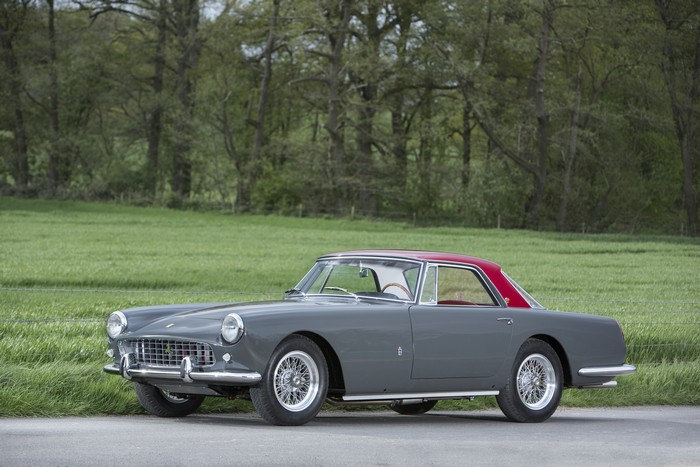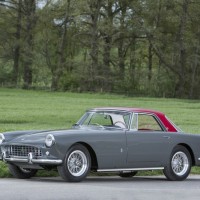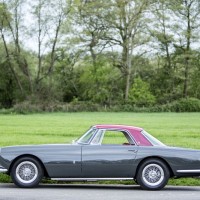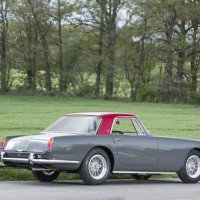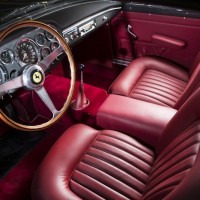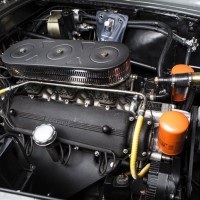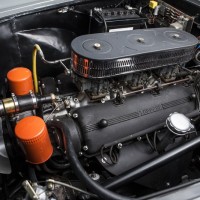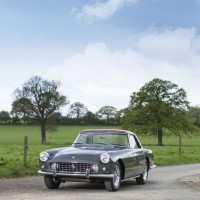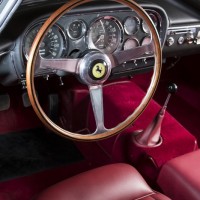With the 250 engine came a family of cars that turned Ferrari from a small-scale marque to a world-renowned manufacturer. This range was based on a powerful 3-liter V12 engine designed by Gioacchino Colombo. The engine was adaptable to use on the road or the track. After the first examples of the 250 Ellena and 250 GT Europa, the development of this group of cars took off in 1958 with the arrival of the 250 GT PF coupe, designed by Pininfarina, who was also in charge of building it. It became the spearhead model for the marque, with competition versions built at the same time, including the legendary 250 GTO.
Delivered new in Europe, this Ferrari spent a large part of its life in the United States before it was imported into Holland 10 years ago. It had been repainted red but retained its original red interior. The engine had been replaced by a correct 250 GT engine with the improved outside spark plug cylinder heads. The brakes had also been sensibly upgraded to discs all round. The car remained in dry storage for several years before being bought by the current owner in Holland. The bodywork was very sound, but the rubber seals and pipes needed an overhaul, as the car had previously been standing for a long time in a hot climate.
While in the current owner’s hands, the car has been restored to the original configuration. A great deal of work was carried out by the very best workshops — ensuring that the car is presented in a splendid condition today. The V12 engine sounds sublime, and the car changes through the gears beautifully. Here is a stunning example of a great classic. The 250 GT is at the heart of the empire that Ferrari represents today. As such it carries strong historical value — in addition to being a truly outstanding car— providing a wonderful drive and a thrill to look at.
SCM Analysis
Detailing
| Vehicle: | 1958 Ferrari 250 GT Coupe |
| Number Produced: | 353 |
| Original List Price: | $12,600 |
| Tune Up Cost: | $3,500 |
| Chassis Number Location: | Front frame tube |
| Engine Number Location: | Right rear engine mount |
| Club Info: | Ferrari Club of America |
| Website: | http://www.ferrariclubofamerica.org |
This car, Lot 251, sold for $445,051, including buyer’s premium, at Artcurial Paris on June 10, 2013.
Enzo Ferrari hit on the right combination from the beginning. His cars are a mixture of high performance and beautiful styling, with a price tag so high that only the wealthy can afford one — and everyone else dreams of having one.
Most of the early Ferraris were built in small runs designed either for competition or dual-purpose use. There were a few street cars sprinkled in to help fund the racing effort, but it wasn’t until the 250 series that Ferrari built any model in meaningful quantity.
Prior to the 250 series, the most prolific Ferrari series was the 212 series, which totaled around 100 examples. By comparison, there were around 25 distinct 250 models totaling over 2,500 cars.
The 250 GT coupe Pininfarina was designed from the onset to be a luxury Grand Touring car. The factory brochure features two shots of beautiful models dressed to the nines standing next to the car. Another shot shows five pieces of luggage next to an open trunk. The images illustrate how this car is all about the good life. There is no illusion that this is a dual-purpose boy racer.
The Pininfarina coupe is a study in minimalist design. A simple notch-back roof is placed on an elegant rectangular body. There are few compound curves and few frills. There is no pretense of speed or high style. The result is one of the cleanest designs of all Ferrari models.
One model, two series
There are two series of the Pininfarina coupe. The first series features an inside-plug engine with a 4-speed transmission, drum brakes and lever shock absorbers. At about chassis number 1,499, Ferrari started updating PF coupes with an outside plug engine, disc brakes, tube shocks and overdrive transmission — although not all at the same time. The later cars are commonly called Series IIs.
Outside-plug and inside-plug engines refers to the placement of the spark plugs. The inside-plug engines have spark plugs on the inside of the head, near the carburetors. Outside-plug engines have spark plugs on the outside of the heads near the headers. Outside plugs allowed the engine to breathe better. Outside-plug engines also feature four head studs per each cylinder instead of three and twin distributors.
Permanent changes
The Ferrari Market Letter records note that by 1976, Chassis 1023 already had a replacement inside-plug engine. Later notes show that around 1994 the inside-plug unit was scuttled in favor of the outside-plug engine that is in the car today. The car was also updated to disc brakes and Koni tube-style shocks.
The brake and shock updates were very popular and were performed on many early PF coupes. These updates were also done on many early Ferrari race cars. Don’t think you can buy a PF coupe and just reverse the updates. High-end vintage events often require vehicles to be in original configuration. Even if you could find a rare set of drum brakes or an inside-plug engine, you will find yourself bidding against someone needing the same parts to make a multimillion-dollar Ferrari race-car eligible for a Mille Miglia-type event or a major concours. The big money will prevail.
For many years, 250 PF coupes were near the bottom of the Ferrari price chain. They were often an engine rebuild away from the salvage yard. A proper restoration was out-of-the-question expensive. Maintenance was whatever Band-Aid would get one a little farther. A few were lost to accidents, a few more were lost to the elements and quite a few more were salvaged for parts or became donors for re-creations. Quality survivors are quite rare and only recently have they become valuable enough to warrant a proper restoration.
Our subject car’s original engine is reportedly in a Series I 250 Pininfarina Cabriolet belonging to William Marriott. That engine’s not coming home. Chassis 1023 isn’t going to go vintage racing or get invited to Pebble Beach, so the disc-brake conversion is a plus. The former owner apparently had the inclination and resources to bring the car back to its former glory. It appears to be a very attractive example of a relatively rare model. This Ferrari is far from original — but quite acceptable for its ilk.
Not a top price, but well sold
I recently got an email that a 250 GTO had just sold for over $50,000,000. If that’s true, the number’s up nearly 50% from one sold less than a year ago.
A PF coupe is a very distant sibling from a GTO — but not that far removed from a few other very expensive 250s. It seems most vintage Ferraris are on a price run and 250s are especially hot. Chassis 1023 was not a top-of-the-market example, yet it sold for what had to be a near-record price.
I have to chalk this one up to the seller. He may have missed the top of the market, but 50% growth can’t go on forever. Sometimes it’s smart to cash out when you’re ahead and let the next guy gamble on the future. ?
(Introductory description courtesy of Artcurial Motorcars.)
